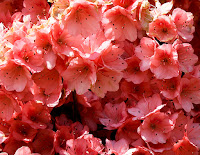Ferida Wolff's Backyard: Nature's Progression and A Robin's Beautiful Eggs
Nature’s Progression
Author's Note: As our communities become more urbanized, the natural features around us tend to get pushed into the background and often go unnoticed. In “Ferida’s Backyard,” I look at the details of nature locally, from a neighborhood perspective, frequently from a backyard vantage point. It excites me to share what I see. An awareness of the natural connection can beautifully enhance our lives.
Editor's Note: We're at a moment when Harper Lee's book has received a new rush of enthusiasm through its current Broadway play version. Consequently, we thought we'd look up one explanation of the azaleas's symbolism in To Kill a Mockingbird:
What do Miss Maudie's azaleas symbolize in To Kill a Mockingbird?
To Kill A Mockingbird contains many symbols, starting with the title. In the fight for justice, innocence is lost. It is "a sin to kill a mockingbird," because in singing "their hearts out for us," they have no malice or personal agendas—much like Tom Robinson in feeling sorry for Mayella Ewell and trying to ease her apparent suffering.
Flowers are a recurring symbol in the book and as Atticus refuses to judge anyone in his community of Maycomb County and looks for the good (the beauty) in everyone, flowers are a reminder of that. People are rude and offensive and their behavior is often disgraceful and yet, Atticus instructs his children to accept and respect the views of others, even when those thoughts are intrinsically flawed and even wicked. Flowers provide the stark contrast between his attitude and that of most of his community. Furthermore, Mayella's harsh life conflicts with a show of color, even though her geramiums are grown in "chipped-enamel" jars.
In terms of Miss Maudie, she does not want to be stereotyped or stay indoors, because that would be "time wasted," even if the Maycomb community expects her to. Her azaleas provide the contrast between her friendly disposition and the bitterness and hypocrisy in Maycomb County. Her azaleas need nurturing, and are also a symbol of her efforts to nurture not only her azaleas, protecting them from the snow, but also the children, who are free to spend time with her as long as they do not spoil her azaleas. She also likes the bright colors; she does not discriminate one color over another — a subtle reference to the racial prejudice by which she is surrounded.
Pages: 1 · 2
More Articles
- Ferida Wolff's Backyard: Spring is Coming
- Ferida Wolff's Backyard: Shifting Seasons: We Need to Remember That We Are Strong Underneath, That Things Change and That the World is Flexible.
- Ferida Wolff's Backyard: Bee-side Our Window
- Ferida Wolff Writes: Our Senses
- The Autobiography of a Garden at The Huntington, a Joy for Viewers and Gardeners
- Ferida Wolff's Backyard: Caring for Our Climate and Our Earth; Inside and Outside; NASA's New Spacesuit for Artemis Generation Astronauts
- Ferida Wolff's Backyard: Swans and Duck Together; Life Ripens and Robin's Beautiful Eggs
- Ferida Wolff's Backyard: Flowering Plum and Vincent Van Gogh
- Ferida Wolff's Backyard Garden: My Surprising Garden and Basil is a Great Herb
- Ferida Wolff's Backyard: Rabbit in the Bush; Seasons and Changing Climate







